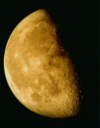
Lunar Images
This Last Quarter Moon was one of the first photographs I took with my Celestron SCT in September 1999. I used a small semi automatic compact, a Vivitar 35EM, afocally with a 26 mm eyepiece, and ISO 200 colour film. Unsharp masked. This image appeared monochrome in the July-September 2007 issue of the SPA magazine.

The early morning of January 21st. 2000 saw a beautiful clear sky and a deep red total eclipse of the Moon. The magnitude 7.6 star TYC 1385-1065-1 was due to be occulted during totality, and I was able to capture the approach in these three photos. They were taken with the Vivitar 35EM compact afocally with a 26 mm eyepiece. ISO 200 film, approx. 10 second exposures. Slightly out of focus unfortunately. (Well, it was after 4 am!). The instant of occultation was timed at 0416.58 at Boldon, Tyne & Wear, England. These photos were published in the June 2000 issue of Astronomy Now as Picture of the Month.

After I got the VCam the Moon was an easy target to practice on. Note that most of the VCam Lunar images have been converted to greyscale. Occasionally the camera introduces false colours, particularly on the highlights, and of course the greyscale images take less time to download.
|
January 26th. 2000. There was a clear waning gibbous Moon, and I took a number of images along the terminator which gave this mosaic, stitched together in a venerable (1993) version of Picture Publisher. |
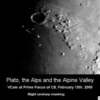 -
-
|
While the Moon always turns the same face to the Earth, nevertheless the view is not totally static. It appears to nod rather like a toppling gyroscope, a phenomenon known as 'Libration'. This allows us to see more of the Moon's surface than would otherwise be visible. The effect is shown by comparing this image of Plato (unfortunately not quite as crisp as the other one) taken on May 12th, with the above February 13th image - the Moon appears to be tilted at a different angle to the Earth. (But if I've misinterpreted these images, someone please tell me - I'd hate to mislead anyone.) |
|
Although I had a good image of Theophilus and friends from the 26th. January session, this one from 11th. March 2000 is better! |
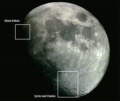 -
-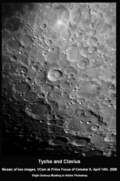 -
-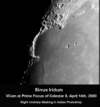
|
This photo was taken on 20th. April 2000 through my recently acquired Celestron Wide Angle Telescope. At prime focus, the image was just too large to fit on the chip in one frame, so two shots were taken then stitched together. Not quite as crisp as the C8 images, but the nearness to full Moon does not help the contrast. |
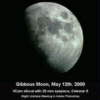 -
- -
-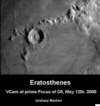 -
-
A month or so later, with the Moon closer to full. Not as crisp, but until I get a better chance ..... Nevertheless it's interesting to see how the lava of Mare Humorum just entered the crater Gassendi (at the top of the picture) and half drowned Doppelmayer (bottom).
 -
-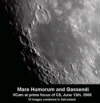
Actually the seeing was good, but the Moon was quite low in the sky (altitude 20 degrees), so the thickness of the atmosphere affected the image. A collimation check using Arcturus (much higher at 50 degrees altitude) proved good collimation and steady sky, as seen by these three consecutive out of focus patterns:
 -
- -
-
The following night with the Moon almost full, it was even lower in the sky at 16 degrees altitude when the following shots were taken. I was after Schröter's Valley, and got a picture, but not very good - the light angle was not ideal, and the atmosphere was murky. But there was a reasonable view of the interesting crater Wargentin next to the large walled plain Schickard. This crater filled with lava from the inside, and forms a plateau above the surrounding terrain. The mosaic is of the general SW terminator. When the Moon is higher later in the year, I'll repeat these shots and hope for better definition. LATER! See below for Schröter's Valley!
 -
- -
-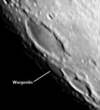 -
-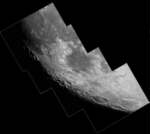
|
The small hours of 20th. August gave a clear sky with good seeing and a bright waning gibbous Moon. I imaged most of the terminator, and a couple of sections are also shown in more detail. If you want to view the enlargement of the terminator, please be aware that it is 74 Kb in size. Aristoteles and Eudoxus ---Ariaedeus Rille and part of Hyginus Rille |
After over a week of cloud, during which I built my dew heater and distribution panel, I finally got an opportunity to try them out when the sky cleared for a short while in the early hours of September 17th. 2000. Before they rolled in again, I managed to image part of the terminator of the waning gibbous Moon, in quite good seeing. The dew heater did a grand job!
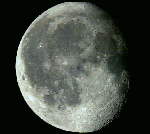 ----------
----------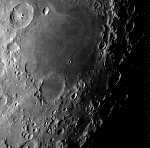 ----------
----------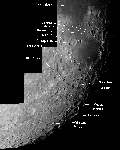
|
The following evening, September 18th, the terminator had moved on to give a nice grouping of Plato, the Alps, The Alpine Valley, Aristoteles and Eudoxus. The seeing was again quite good, and I couldn't resist it! |
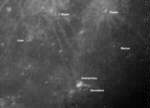 --------
--------
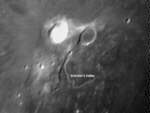
Prime Focus -------- -------- -------- 3x Barlow
Ever since I started imaging the Moon, I have wanted to capture Hadley Rille. But the excellent conditions needed for this difficult subject never coincided with the required phase and personal availability. Until March 3rd. 2001! So here is the result of that imaging session. Not only did I capture a decent image of Hadley Rille, but also Rima Birt, the rille parallel to the Straight Wall and three craterlets in Plato. All images taken with my LX90 SCT and Vesta Pro Web Camera at Cassegrain focus with 3x Barlow, stacked in Astrostack, final processing in Adobe Photoshop.
|
|
|
|
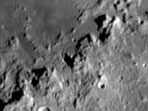 |
 |
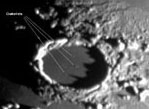 |
|
A bright Moon generally spells death to deep sky imaging, other than narrow band filtering. But of course the Moon itself is a wonderful subject - bright so ultra short exposures, contrasty and easily found! So the night of 16th February 2008 found me imaging it with my Artemis 285. Full frames take around 12 seconds to download, so taking hundreds of frames for stacking is out of the question. But careful choice of a few good frames works quite well, and with decent seeing a good result can be obtained. One advantage of using the 16-bit Artemis is the much improved dynamic range, producing a natural looking image. This one shows the upper part of Mare Imbrium , featuring Sinus Iridum to the left, and crater Plato with the Alps. Full Size (321 KB) |
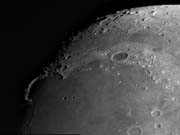 |
|
Then towards the South of the Moon, a study of the huge crater Clavius with Tycho above. Even in this gibbous phase the streaks of ejecta from Tycho are clearly visible. Both these images were taken with the Artemis 285 and 12" LX200 ACF at f10. Individual exposure times 1/50th second. I used a Red filter to improve contrast. Full Size (547 KB) |
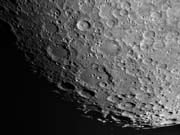 |
|
The early hours of 21st February 2008 saw a total Lunar Eclipse. But not for me! Out of 9 clear nights there was only one cloudy one, the 7th of the nine and it was the night of the eclipse. Typical!! And there isn't another full sequence visible from the UK until 2015. But a couple of days earlier (19th February) ice clouds high in the atmosphere produced a beautiful Lunar Halo which I was able to capture. Canon 350D with 17 mm lens at f7.1, single 30 second frame at ISO 200. Hot pixels removed in Photoshop, smoothed in Neat Image. You can see the Sickle of Leo and Saturn lower left inside the circle. Castor and Pollux top right, Procyon to the right. The halo is produced by refraction of Moonlight at an
angle of approximately 22 degrees, so the diameter of the
halo is always 44 degrees. It just fitted in the field of
view. A few weeks later during the visit to Kielder (below)
I obtained a photo of the similarly formed Solar
Halo. |
 |
|
During the 2008 Spring Kielder Star Camp while staying at Calvert Trust, the Sunday (6th. April) night promised a very young New Moon, but unfortunately the sky never cleared. And remained mostly cloudy for the rest of the stay at Kielder. But a brief glimpse of the New Moon the following evening yielded this nice Earthshine photo. Canon 350D, single 4 second frame at ISO400 and 170 mm focal length. Larger image. |
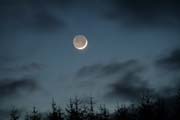 |
|
The weekend of 28th March 2009 was the climax of the annual Spring Kielder Sky Camp. I and some friends stayed in a log cabin for most of the preceding week, but our heart went out to those camping - Thursday and Friday were cold and wet in the extreme! Even the earlier part of the week afforded only glimpses of the night sky. But Saturday evening opened with a beautiful thin crescent Moon in the western sky. This photo, taken with my Panasonic TZ5 digicam shows the Moon with Earthlight hanging above the trees to the west of the cabin. Reminiscent of the above, taken a year earlier! |
|
|
I had my Meade Series 5000 127 mm refractor with me on my EQ6 Pro mount, and the crescent fitted nicely into the field of view with the ST10 XME. So using a Hydrogen-alpha filter to reduce the glare I was able to obtain this image. This is the best frame picked out of 10 x 1 second frames. (Combining produced a less crisp image). |
|
During the 2009 Spring Moonwatch week (part of the International Year of Astronomy) I was on holiday for a few days in Ambleside in the English Lake District. I took a telescope along with me in the hope of 'wowing' some of the guests at the hotel with a closeup of the Moon. And I wasn't disappointed! Over the four nights I was there about 20 guests took advantage of the opportunity, and only one of them had ever seen the Moon through a telescope before. Saturn was also on show and elicited exclamations of wonder, although appearing very small at the maximum 81x magnification available using a Hyperion zoom eyepiece (8 - 24 mm) on my 4" TMB refractor (650 mm focal length). Some nights were rather hazy, but Thursday 2nd April was beautifully clear with good seeing, and several guests took the opportunity to photograph the Moon afocally with cameras ranging from mobile phones to full size digicams. I also obtained a nice image with my Panasonic TZ5 digicam. Of particular interest was the bright spot of crater Ammonius catching the rising sun within crater Ptolemaeus while immersed in the pointed shadow of a high mountain on the main crater wall. Here. A number of guests departed vowing to buy a telescope - definitely a successful Moonwatch! This was later featured in the John Lewis Partnership House Magazine 'Connections' for July 2009 and in the July to September 2009 issue of the SPA magazine. |
|
|
On December 21st 2010 just before dawn there was a total eclipse of the Moon. Visible from the UK, but only just as it set in the West. Fortunately it was a beautifully clear morning (but bitterly cold at -10 deg C) and despite a mishap with my EQ3-2 mount I was able to take some photographs. All with my Canon 350D and 400L telephoto lens, ISO200 and f7.1 Full sizes: 1 1/250 sec. 2 1 sec. 3 2 secs. 4 3.2 secs. As I was lifting everything over a farm gate across the road from my home to give me a clear view from a public footpath the whole bl**dy thing fell over - the gate that is, with me on top and the mount underneath. It was just leaning against the gateposts with no hinge, not even a bit of binder twine!! And of course in the dark I didn't realise until it was too late. So one damaged and unusable tripod. Although the camera and lens were attached to the mount head, fortunately the damage was limited to the tripod. I also have an EQ6 Pro mount - my 'Star Party' mount. So out of the box in my garage and set up. But time lost, so I wasn't ready until almost 7 am by which time the Eclipse was well advanced. Nevertheless, although I didn't get a full record of the early stages, and by totality it was only 6 degrees above the horizon and dawn was breaking, I'm happy enough with what I did get. And thanks to help via the 'net I've got replacement parts to repair the damaged tripod. On checking with Skymap to be sure that what looked like stars *were* stars, it's interesting to think that the only time you'll get to see a mag 7 star occulted by the Full Moon is during an Eclipse! The star at 4-o-clock in the bottom frame was behind the Moon two minutes earlier. It's mag 7.84 TYC 1863-1976-1 Unfortunately because of the accident with the mount I don't have a photo before the Moon occulted it, although at that time (0652) the Lunar limb next to the star would have been in the Umbra. |
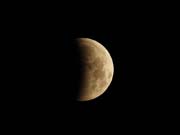
|
|
Unfortunately the wide angle shots I took (50 mm Zoom) were slightly out of focus. But for what it's worth, here is one, showing the totally eclipsed Moon over the snowy landscape. |
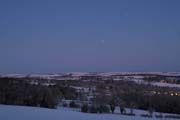 |
|
On the evening of 20th February 2015 Venus and Mars were joined by a thin Crescent Moon in the Western Sky. This image is a composite of two separate exposures - strips of cloud meant that unfortunately not all were properly visible together at any time. But I think it came out ok. The Earthshine on the Moon is particularly striking! Larger image Canon 700D, 15 second images with 70-200 mm lens at 200 mm and f6.3 |
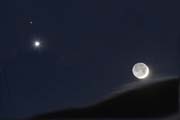 |
|
The end of September 2015 saw a week of stable High Pressure givng beautiful sunny days and clear nights although mist tended to thicken later in the nights. And this coincided with a particularly fine total Lunar Eclipse of a 'Super Moon' i.e. at its closest to the Earth in its orbit in the early hours of 28th. I used my Canon 700D on my Meade 127 refractor to obtain detailed images, a selection of these is in the montage showing the progress of the eclipse (from right to left). Larger image. As always click on the thumbnails for a medium size image. |
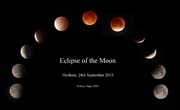 |
|
Close up of the fully eclipsed Moon. It is apparent that the lower part of the Moon is brighter - this is because it did not pass through the centre of the Earth's shadow, but was nearer the bottom of the main umbral shadow. And yes, those little bright dots are stars! The brightest is a double star, magnitude 7.8 Larger image. |
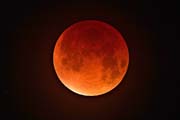 |
|
The low passage through the umbra is clearly seen in this triple montage where the crescent images are arranged to show the shape of the umbra with the totally eclipsed Moon in its relative position. Larger image. This montage appeared in the November 2015 and January 2019 issues of Astronomy Now magazine, and a section of the totally eclipsed Moon appeared in the North American Observing Highlights section of the January 2018 issue. |
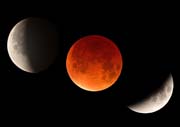 |
|
I also had my venerable Canon 350 set to take wide angle images on my EQ3-2 mount with a 50 mm Tamron lens. The star field was 3 x 3 minute subs, then the over exposed Moon was replaced with one from 5 x 5 second subs. The Moon was in Pisces and the 'Circlet' is clearly seen.All at f5.6 and ISO800. Larger image.
|
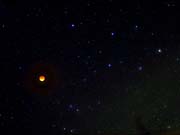 |
|
A couple of days before the Eclipse I was checking my 700D/Meade 127 setup and obtained this image of the Gibbous Moon. Had a play with it to bring up the colour for a bit of fun. So here it is. Larger image.
|
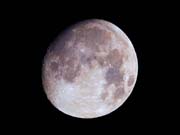 |
|
Postscript. The next total Lunar eclipse the entirety of which will be visible from my home will be in the early hours of 21st January 2019. While there are others before and after that event, one or two showing totality very low in the sky, the next entirely visible one will not be until 20th December 2029. Well, I'll be 86 by then if I live that long. Better make the most of 2019 and hope for clear skies! |
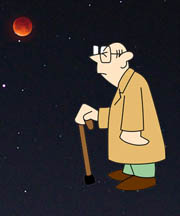 |
|
The total Lunar Eclipse of January 21st 2019 as mentioned above was to be the last fully visible from the UK until 2029, so fingers were firmly crossed! Although the weather in general was very poor during December 2018 and January 2019, I was fortunate with sky conditions, and managed to image the eclipse right through to the exit from the Umbra. Unfortunately although the sky was decently clear for totality it hazed over as time progressed. Nevertheless I was able to capture a good selection of images. So here is a composite of before and after with the images in correct configuration and spacing to show the shape of the Umbra. This image appeared in the Astronomy Now magazine Gallery for March 2019 Larger image Canon 700 D on Meade 127 refractor (950 mm fl), all at ISO100 The exposure hour times and settings were: Before 0403 1/200th second |
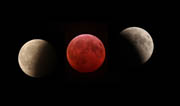 |
|
And here is a single image of Totality. This eclipse was not as bright as the previous one in 2015, and with thin haze not as stunning visually, but still a wonderful sight - a perfect demonstration of celestial mechanics in action! Larger image Post script May 2022 following a very low partially visible total eclipse in the early hours of 16th, twilit but completely clouded out here - I didn't even try to see it! Anyway, this 2019 eclipse was pretty good. The December 2029 one IF the sky is clear will be a particularly stunning spectacle with the Moon at 54 degrees altitude, 15 degrees directly above Betelgeuse. Quite close to the Southern edge of the umbra, nevertheless a superb wide field opportunity to have the totally eclipsed Moon in the same frame as the Orion constellation. Probably guaranteed to be cloudy. Maybe I'll still be around! (78 years old when writing this). |
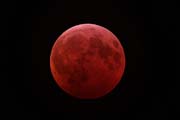 |
|
Unusual for me, I rarely image the Moon now. But 27th March 2023 was a gorgeous day after weeks of cloud, in the early evening the Moon was high and bright and seeing quite good, so I couldn't resist it. And wanted to see how my almost new SharpStar 140 would cope with the bright Moon. Which I think you'll agree it has done so admirably. This is a mosaic of two images, each the result of stacking 25 from just over 100 frames using my monochrome GPCAM3. The full size image is 700Kb but well worth a look for fine detail. 'Mouseover' the medium size image for names of numerous features. |
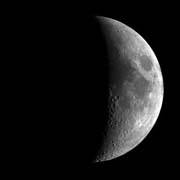 |
|
As I said in my offering above I rarely image the Moon. But typically we've had two clear nights on the trot with the very bright Moon near my current deep sky target. And when you consider how much less hassle it is to get a few minutes of Moon instead of hours for deep sky it seems daft not to make use of the opportunity! I particularly wanted to get a reasonable shot of the interesting Schröter's Valley area, not visited for many years, so I set to on both 2nd and 3rd of April.
Much better seeing on 2nd, so the (full size) disc is presented here along with an enhanced double sized clip of Schröter's. Full disc a mosaic of 3 image sets. Altair GPCAM3 (mono) on SharpStar 140 refractor. At my location in the lee of the Pennines the seeing is rarely stable. Maybe next time round my 10" RC will be on the mount and I'll give it a go for some close ups. I don't think I'll try for a full disc - it would need a huge mosaic! Full size Moon (1.1MB)
Schröter's a bit over shadowed, so another look on 3rd, this time a 'Region of Interest' image so a lot more subs, but seeing not so good. But here it is, again double sized, for completeness.
Click on the thumbnails for full size Schröter's. |
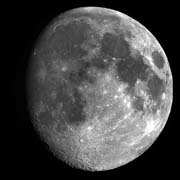
|